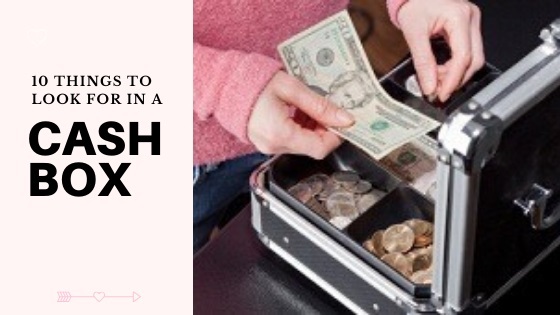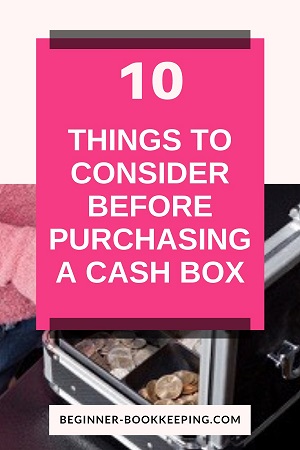- Home
- Bookkeeping Basics
- Locking Cash Box
Locking Cash Box
10 Things to consider before purchasing a locking cash box
1. Choose the right Size

The size you chose will be influenced by:-
- how much cash (the float) you intend to keep in it
- how much paperwork such as vouchers and receipts you will hold in it
- where you are going to keep it – in a large cupboard or a small drawer
- what you intend to do with it
- will it stay in your office and be used for small purchase items for the office –
choose a small to medium locking cash box, or - will you be using it on your stand when you are selling products at the market requiring plenty of change -
choose a medium to large locking cash box
2. Find a Style that is practical
I recommend getting:-
- one with a handle in the lid for easy carrying (like in the options above)
- rounded corners/edges so there’s less chance of hurting your hand on sharp edges and pointy corners (most options above)
- one with an inner tray that can be removed (most options above)
There are some very interesting options like ones that look like a large book (what thief would think to look in a ‘book’!) or treasure chests (a bit more obvious to a thief but fun for children’s pocket money!).
3. Check it for Strength and Sturdiness
Most cash safe boxes are made of steel, which is the best tamper proof material, but some are thin steel and others thick.
If your locking cash box is not going to see much action then a cheaper, lighter type should be good enough.
However, if it is going to be hauled around in a vehicle, on flights or used at the markets then a stronger, heavy duty type is better.
The inner trays are either metal or strong plastic.
4. Get inner accessories for different uses
Select a locking cash box that has a removable tray inside with partitions for placing coins, cash notes and petty cash vouchers.
Usually, the tray sits near the top of the box so that cash notes, receipts and vouchers can fit underneath (or jewelry and other personal items if this is not for business use).
Some boxes have sprung clips in the lids or on the base for holding the cash notes secure – a fantastic feature if you are an organized person.
5. look for a Good Locking Mechanism
The most common type of lock is an inbuilt one with a small set of 2 keys.
Keep one key in the office and the other one off-site somewhere else that is secure.
Some cash boxes have a combination lock – a fantastic option if you are prone to losing keys, but you just must be good at remembering the combination number!
There is also battery operated, digital options for which you simply set an access code. Or biometric ones for using a finger print.
These are more drawer type safes without an inner tray for holding coins but you can always put a small container in it for holding coins and cash.
6. Find your Color
The majority of cash boxes are in various shades of grey or metal gray.
The benefit of this color is that it helps the box blend in more easily with the surroundings and is less easy to spot by thieves so remember this if you have to take your cash box out to market.
But there are a few colors available if you want a bit of brightness in your life.
7. Select a safe place to keep it
In the office situation the best place for it is out of sight in a locked cupboard or drawer.
Why tempt a thief by having it in plain view?
This is especially true if you have a lot of visitors to your office.
If you have a large safe you can keep the locking cash box in it overnight.
8. decide Who is responsible for it
If there are several employees in your office, only one person should be allocated responsibility for receiving and distributing the cash out of the box.
Anyone in the office needing cash simply needs to fill in a petty cash voucher, give it to this petty cash person who then hands out the amount required, and inserts any change that comes back.
A different employee should be responsible for processing the petty cash log reconciliation each month, checking through the vouchers and counting the cash.
This is a safety measure for spotting any errors and preventing theft.
9. Should you get A Cash Box or a Safe?
If you are looking for a way to store your special personal or business items that you don’t need to carry around with you on your travels or from a drawer to a desk, then you could buy a safe instead.
These are much heavier, stronger and way more difficult to break open.
10. Day to day management of the cash
If you or your employees do not know how you are supposed to handle the records of the cash going in and out the box, you can read my post on the procedures for setting up the petty cash system and day to day management of the cash using a log and vouchers.
There are free printable templates of the log and vouchers on that post also.
If you don't want to spend money on a locking cash box, you can check our Pinterest board about DIY Cash Boxes which may give you some ideas.



